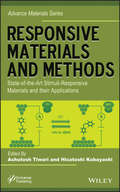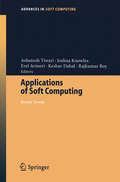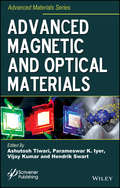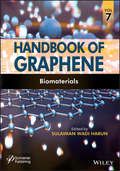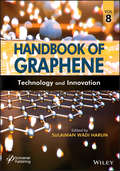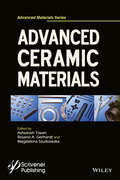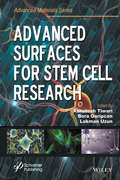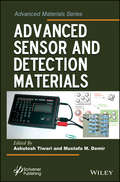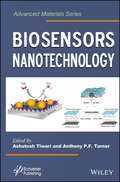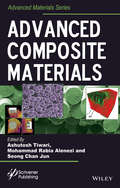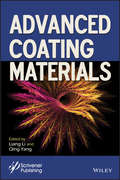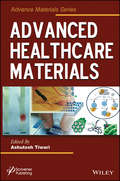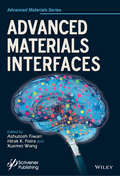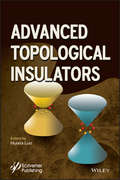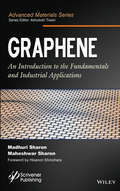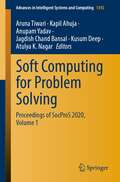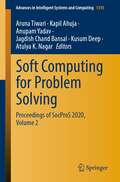- Table View
- List View
Responsive Materials and Methods: State-of-the-Art Stimuli-Responsive Materials and Their Applications (Advanced Material Series)
by Ashutosh Tiwari Hisatoshi KobayashiThe development of finely-tuned materials that adjust in a predictable manner by specific environment change is the recent arena of materials research. It is a newly emerging supra-disciplinary field with huge commercial potential. Stimuli-responsive materials answer by a considerable change in their properties to small changes in their environment. Responsive materials are becoming increasingly more prevalent as scientists learn about the chemistry and triggers that induce conformational changes in materials structures and devise ways to take advantage of and control them. Responsive Materials and Method offers state-of-the-art of the stimuli-responsive materials and their potential applications. This collection brings together novel methodologies and strategies adopted in the research and development of responsive materials and technology.
Responsive Materials and Methods: State-of-the-Art Stimuli-Responsive Materials and Their Applications (Advanced Material Series)
by Ashutosh Tiwari Hisatoshi KobayashiThe development of finely-tuned materials that adjust in a predictable manner by specific environment change is the recent arena of materials research. It is a newly emerging supra-disciplinary field with huge commercial potential. Stimuli-responsive materials answer by a considerable change in their properties to small changes in their environment. Responsive materials are becoming increasingly more prevalent as scientists learn about the chemistry and triggers that induce conformational changes in materials structures and devise ways to take advantage of and control them. Responsive Materials and Method offers state-of-the-art of the stimuli-responsive materials and their potential applications. This collection brings together novel methodologies and strategies adopted in the research and development of responsive materials and technology.
Applications of Soft Computing: Recent Trends (Advances in Intelligent and Soft Computing #36)
by Ashutosh Tiwari Joshua Knowles Erel Avineri Keshav Dahal Rajkumar RoyThis book provides a comprehensive overview of recent advances in the industrial applications of soft computing. It covers a wide range of application areas, including optimisation, data analysis and data mining, computer graphics and vision, prediction and diagnosis, design, intelligent control, and traffic and transportation systems. The book is aimed at researchers and professional engineers engaged in developing and applying intelligent systems.
Advanced Magnetic and Optical Materials (Advanced Material Series)
by Ashutosh Tiwari Parameswar K. Iyer Vijay Kumar Hendrik SwartAdvanced Magnetic and OpticalMaterials offers detailed up-to-date chapters on the functional optical and magnetic materials, engineering of quantum structures, high-tech magnets, characterization and new applications. It brings together innovative methodologies and strategies adopted in the research and development of the subject and all the contributors are established specialists in the research area. The 14 chapters are organized in two parts: Part 1: Magnetic Materials Magnetic Heterostructures and superconducting order Magnetic Antiresonance in nanocomposites Magnetic bioactive glass-ceramics for bone healing and hyperthermic treatment of solid tumors Magnetic iron oxide nanoparticles Magnetic nanomaterial-based anticancer therapy Theoretical study of strained carbon-based nanobelts: Structural, energetical, electronic, and magnetic properties Room temperature molecular magnets – Modeling and applications Part 2: Optical Materials Advances and future of white LED phosphors for solid-state lighting Design of luminescent materials with “Turn-on/off” response for anions and cations Recent advancements in luminescent materials and their potential applications Strongly confined quantum dots: Emission limiting, photonic doping, and magneto-optical effects Microstructure characterization of some quantum dots synthesized by mechanical alloying Advances in functional luminescent materials and phosphors Development in organic light emitting materials and their potential applications
Advanced Magnetic and Optical Materials (Advanced Material Series)
by Ashutosh Tiwari Parameswar K. Iyer Vijay Kumar Hendrik SwartAdvanced Magnetic and OpticalMaterials offers detailed up-to-date chapters on the functional optical and magnetic materials, engineering of quantum structures, high-tech magnets, characterization and new applications. It brings together innovative methodologies and strategies adopted in the research and development of the subject and all the contributors are established specialists in the research area. The 14 chapters are organized in two parts: Part 1: Magnetic Materials Magnetic Heterostructures and superconducting order Magnetic Antiresonance in nanocomposites Magnetic bioactive glass-ceramics for bone healing and hyperthermic treatment of solid tumors Magnetic iron oxide nanoparticles Magnetic nanomaterial-based anticancer therapy Theoretical study of strained carbon-based nanobelts: Structural, energetical, electronic, and magnetic properties Room temperature molecular magnets – Modeling and applications Part 2: Optical Materials Advances and future of white LED phosphors for solid-state lighting Design of luminescent materials with “Turn-on/off” response for anions and cations Recent advancements in luminescent materials and their potential applications Strongly confined quantum dots: Emission limiting, photonic doping, and magneto-optical effects Microstructure characterization of some quantum dots synthesized by mechanical alloying Advances in functional luminescent materials and phosphors Development in organic light emitting materials and their potential applications
Handbook of Graphene, Volume 7: Biomaterials
by Ashutosh Tiwari Sulaiman Wadi HarunThe seventh volume in a series of handbooks on graphene research and applicationsThe Handbook of Graphene, Volume 7: Biomaterials presents an overview of various graphene research initiatives and specific biomedical applications, where the properties of graphene are used differently. The book shares information on how graphene and graphene-based materials are utilized for the following types of applications: bio-targeting; medical and biomedical; drug delivery; antibacterial; and biological, biosensing and bioimaging. Topics covered include the role of graphene-based materials in: regenerative medicine; resistive memories and transistors; and implants in biomedicine. The impact of graphene-based biomaterials on biomedical applications is discussed, as are graphene-based systems in the delivery of therapeutics to the brain and central nervous system.
Handbook of Graphene, Volume 8: Technology and Innovations
by Ashutosh Tiwari Sulaiman Wadi HarunThe eighth volume in a series of handbooks on graphene research and applicationsThe Handbook of Graphene, Volume 8: Technology and Innovations discusses the role of graphene-based applications in technological advancements. Topics include graphene materials used in circuit board repairs; RFID antenna and sensor fabrication; and wearable healthcare electronics. Chapters present detailed information on: modeling methods used in graphene research; applications of graphene-on-silicon photonic integrated circuits; the development of graphene for engineering applications; and other graphene subjects of interest to scientists, chemists and physicists.
Advanced Ceramic Materials (Advanced Material Series)
by Ashutosh Tiwari Rosario A. Gerhardt Magdalena SzutkowskaCeramic materials are inorganic and non-metallic porcelains, tiles, enamels, cements, glasses and refractory bricks. Today, "ceramics" has gained a wider meaning as a new generation of materials influence on our lives; electronics, computers, communications, aerospace and other industries rely on a number of their uses. In general, advanced ceramic materials include electro-ceramics, optoelectronic-ceramics, superconductive ceramics and the more recent development of piezoelectric and dielectric ceramics. They can be considered for their features including mechanical properties, decorative textures, environmental uses, energy applications, as well as their usage in bio-ceramics, composites, functionally graded materials, intelligent ceramics and so on. Advanced Ceramic Materials brings together a group of subject matter experts who describe innovative methodologies and strategies adopted in the research and development of the advanced ceramic materials. The book is written for readers from diverse backgrounds across chemistry, physics, materials science and engineering, medical science, pharmacy, environmental technology, biotechnology, and biomedical engineering. It offers a comprehensive view of cutting-edge research on ceramic materials and technologies. Divided into 3 parts concerning design, composites and functionality, the topics discussed include: Chemical strategies of epitaxial oxide ceramics nanomaterials Biphasic, triphasic and multiphasic calcium orthophosphates Microwave assisted processing of advanced ceramic composites Continuous fiber reinforced ceramic matrix composites Yytria and magnesia doped alumina ceramic Oxidation induced crack healing SWCNTs vs MWCNTs reinforcement agents Organic and inorganic wastes in clay brick production Functional tantalum oxides Application of silver tin research on hydroxyapatite
Advanced Surfaces for Stem Cell Research (Advanced Material Series)
by Ashutosh Tiwari Bora Garipcan Lokman UzunThe book outlines first the importance of Extra Cellular Matrix (ECM), which is a natural surface for most of cells. In the following chapters the influence of biological, chemical, mechanical, and physical properties of surfaces in micro and nano-scale on stem cell behavior are discussed including the mechanotransduction. Biomimetic and bioinspired approaches are highlighted for developing microenvironment of several tissues, and surface engineering applications are discussed in tissue engineering, regenerative medicine and different type of biomaterials in various chapters of the book. This book brings together innovative methodologies and strategies adopted in the research and development of Advanced Surfaces in Stem Cell Research. Well-known worldwide researchers deliberate subjects including: Extracellular matrix proteins for stem cell fate The superficial mechanical and physical properties of matrix microenvironment as stem cell fate regulator Effects of mechanotransduction on stem cell behavior Modulation of stem cells behavior through bioactive surfaces Influence of controlled micro and nanoengineered surfaces on stem cell fate Nanostructured polymeric surfaces for stem cells Laser surface modification techniques and stem cells applications Plasma polymer deposition: a versatile tool for stem cell research Application of bioreactor concept and modeling techniques in bone regeneration and augmentation treatments Substrates and surfaces for control of pluripotent stem cell fate and function Application of biopolymer-based, surface modified devices in transplant medicine and tissue engineering Silk as a natural biopolymer for tissue engineering
Advanced Surfaces for Stem Cell Research (Advanced Material Series)
by Ashutosh Tiwari Bora Garipcan Lokman UzunThe book outlines first the importance of Extra Cellular Matrix (ECM), which is a natural surface for most of cells. In the following chapters the influence of biological, chemical, mechanical, and physical properties of surfaces in micro and nano-scale on stem cell behavior are discussed including the mechanotransduction. Biomimetic and bioinspired approaches are highlighted for developing microenvironment of several tissues, and surface engineering applications are discussed in tissue engineering, regenerative medicine and different type of biomaterials in various chapters of the book. This book brings together innovative methodologies and strategies adopted in the research and development of Advanced Surfaces in Stem Cell Research. Well-known worldwide researchers deliberate subjects including: Extracellular matrix proteins for stem cell fate The superficial mechanical and physical properties of matrix microenvironment as stem cell fate regulator Effects of mechanotransduction on stem cell behavior Modulation of stem cells behavior through bioactive surfaces Influence of controlled micro and nanoengineered surfaces on stem cell fate Nanostructured polymeric surfaces for stem cells Laser surface modification techniques and stem cells applications Plasma polymer deposition: a versatile tool for stem cell research Application of bioreactor concept and modeling techniques in bone regeneration and augmentation treatments Substrates and surfaces for control of pluripotent stem cell fate and function Application of biopolymer-based, surface modified devices in transplant medicine and tissue engineering Silk as a natural biopolymer for tissue engineering
Advanced Sensor and Detection Materials (Advanced Material Series)
by Ashutosh Tiwari Mustafa M. DemirPresents a comprehensive and interdisciplinary review of the major cutting-edge technology research areas—especially those on new materials and methods as well as advanced structures and properties—for various sensor and detection devices The development of sensors and detectors at macroscopic or nanometric scale is the driving force stimulating research in sensing materials and technology for accurate detection in solid, liquid, or gas phases; contact or non-contact configurations; or multiple sensing. The emphasis on reduced-scale detection techniques requires the use of new materials and methods. These techniques offer appealing perspectives given by spin crossover organic, inorganic, and composite materials that could be unique for sensor fabrication. The influence of the length, composition, and conformation structure of materials on their properties, and the possibility of adjusting sensing properties by doping or adding the side-groups, are indicative of the starting point of multifarious sensing. The role of intermolecular interactions, polymer and ordered phase formation, as well as behavior under pressure and magnetic and electric fields are also important facts for processing ultra-sensing materials. The 15 chapters written by senior researchers in Advanced Sensor and Detection Materials cover all these subjects and key features under three foci: 1) principals and perspectives, 2) new materials and methods, and 3) advanced structures and properties for various sensor devices.
Advanced Sensor and Detection Materials (Advanced Material Series)
by Ashutosh Tiwari Mustafa M. DemirPresents a comprehensive and interdisciplinary review of the major cutting-edge technology research areas—especially those on new materials and methods as well as advanced structures and properties—for various sensor and detection devices The development of sensors and detectors at macroscopic or nanometric scale is the driving force stimulating research in sensing materials and technology for accurate detection in solid, liquid, or gas phases; contact or non-contact configurations; or multiple sensing. The emphasis on reduced-scale detection techniques requires the use of new materials and methods. These techniques offer appealing perspectives given by spin crossover organic, inorganic, and composite materials that could be unique for sensor fabrication. The influence of the length, composition, and conformation structure of materials on their properties, and the possibility of adjusting sensing properties by doping or adding the side-groups, are indicative of the starting point of multifarious sensing. The role of intermolecular interactions, polymer and ordered phase formation, as well as behavior under pressure and magnetic and electric fields are also important facts for processing ultra-sensing materials. The 15 chapters written by senior researchers in Advanced Sensor and Detection Materials cover all these subjects and key features under three foci: 1) principals and perspectives, 2) new materials and methods, and 3) advanced structures and properties for various sensor devices.
Biosensors Nanotechnology (Advanced Material Series)
by Ashutosh Tiwari Anthony P.F. TurnerThis book provides detailed reviews of a range of nanostructures used in the construction of biosensors as well as the applications of these biosensor nanotechnologies in the biological, chemical, and environmental monitoring fields Biological sensing is a fundamental tool for understanding living systems, but also finds practical application in medicine, drug discovery, process control, food safety, environmental monitoring, defense, and personal security. Moreover, a deeper understanding of the bio/electronic interface leads us towards new horizons in areas such as bionics, power generation, and computing. Advances in telecommunications, expert systems, and distributed diagnostics prompt us to question the current ways we deliver healthcare, while robust industrial sensors enable new paradigms in R&D and production. Despite these advances, there is a glaring absence of suitably robust and convenient sensors for body chemistries. This book examines some of the emerging technologies that are fueling scientific discovery and underpinning new products to enhance the length and quality of our lives. The 14 chapters written by leading experts cover such topics as: ZnO and graphene microelectrode applications in biosensing Assembly of polymers/metal nanoparticles Gold nanoparticle-based electrochemical biosensors Impedimetric DNA sensing employing nanomaterials Graphene and carbon nanotube-based biosensors Computational nanochemistry study of the BFPF green fluorescent protein chromophore Biosynthesis of metal nanoparticles Bioconjugated-nanoporous gold films in electrochemical biosensors The combination of molecular imprinting and nanotechnology Principles and properties of multiferroics and ceramics
Advanced Composite Materials (Advanced Material Series)
by Ashutosh Tiwari Mohammad Rabia Alenezi Seong Chan JunComposites materials is basically the combining of unique properties of materials to have synergistic effects. A combination of materials is needed to adapt to certain properties for any application area. There is an everlasting desire to make composite materials stronger, lighter or more durable than traditional materials. Carbon materials are known to be attractive in composites because of their combination of chemical and physical properties. In the recent years, development of new composites has been influenced by precision green approaches that restrict hazardous substances and waste created during production. This book ranges from the fundamental principles underpinning the fabrication of different composite materials to their devices, for example, applications in energy harvesting, memory devices, electrochemical biosensing and other advanced composite-based biomedical applications. This book provides a compilation of innovative fabrication strategies and utilization methodologies which are frequently adopted in the advanced composite materials community with respect to developing appropriate composites to efficiently utilize macro and nanoscale features. The key topics are: Pioneer composite materials for printed electronics Current-limiting defects in superconductors High-tech ceramics materials Carbon nanomaterials for electrochemical biosensing Nanostructured ceramics and bioceramics for bone cancer Importance of biomaterials for bone regeneration Tuning hydroxyapatite particles Carbon nanotubes reinforced bioceramic composite Biomimetic prototype interface
Advanced Composite Materials (Advanced Material Series)
by Ashutosh Tiwari Mohammad Rabia Alenezi Seong Chan JunComposites materials is basically the combining of unique properties of materials to have synergistic effects. A combination of materials is needed to adapt to certain properties for any application area. There is an everlasting desire to make composite materials stronger, lighter or more durable than traditional materials. Carbon materials are known to be attractive in composites because of their combination of chemical and physical properties. In the recent years, development of new composites has been influenced by precision green approaches that restrict hazardous substances and waste created during production. This book ranges from the fundamental principles underpinning the fabrication of different composite materials to their devices, for example, applications in energy harvesting, memory devices, electrochemical biosensing and other advanced composite-based biomedical applications. This book provides a compilation of innovative fabrication strategies and utilization methodologies which are frequently adopted in the advanced composite materials community with respect to developing appropriate composites to efficiently utilize macro and nanoscale features. The key topics are: Pioneer composite materials for printed electronics Current-limiting defects in superconductors High-tech ceramics materials Carbon nanomaterials for electrochemical biosensing Nanostructured ceramics and bioceramics for bone cancer Importance of biomaterials for bone regeneration Tuning hydroxyapatite particles Carbon nanotubes reinforced bioceramic composite Biomimetic prototype interface
Advanced Ceramic Materials (Advanced Material Series)
by Ashutosh TiwariCeramic materials are inorganic and non-metallic porcelains, tiles, enamels, cements, glasses and refractory bricks. Today, "ceramics" has gained a wider meaning as a new generation of materials influence on our lives; electronics, computers, communications, aerospace and other industries rely on a number of their uses. In general, advanced ceramic materials include electro-ceramics, optoelectronic-ceramics, superconductive ceramics and the more recent development of piezoelectric and dielectric ceramics. They can be considered for their features including mechanical properties, decorative textures, environmental uses, energy applications, as well as their usage in bio-ceramics, composites, functionally graded materials, intelligent ceramics and so on. Advanced Ceramic Materials brings together a group of subject matter experts who describe innovative methodologies and strategies adopted in the research and development of the advanced ceramic materials. The book is written for readers from diverse backgrounds across chemistry, physics, materials science and engineering, medical science, pharmacy, environmental technology, biotechnology, and biomedical engineering. It offers a comprehensive view of cutting-edge research on ceramic materials and technologies. Divided into 3 parts concerning design, composites and functionality, the topics discussed include: Chemical strategies of epitaxial oxide ceramics nanomaterials Biphasic, triphasic and multiphasic calcium orthophosphates Microwave assisted processing of advanced ceramic composites Continuous fiber reinforced ceramic matrix composites Yytria and magnesia doped alumina ceramic Oxidation induced crack healing SWCNTs vs MWCNTs reinforcement agents Organic and inorganic wastes in clay brick production Functional tantalum oxides Application of silver tin research on hydroxyapatite
Advanced Coating Materials
by Ashutosh TiwariThis book covers the recent advances in coating materials and their novel applications at the cross-section of advanced materials both current and next-generation. Advanced Coatings Materials contains chapters covering the latest research on polymers, carbon resins, and high-temperature materials used for coatings, adhesives, and varnishes today. Concise chapters describe the development, chemical and physical properties, synthesis and polymerization, commercial uses, and other characteristics for each raw material and coating detailed. A comprehensive, yet practical source of reference, this book provides an excellent foundation for comparing the properties and performance of coatings and selecting the most suitable materials based on specific service needs and environmental factors.
Advanced Healthcare Materials (Advanced Material Series)
by Ashutosh TiwariAdvanced materials are attracting strong interest in the fundamental as well as applied sciences and are being extensively explored for their potential usage in a range of healthcare technological and biological applications. Advanced Healthcare Nanomaterials summarises the current status of knowledge in the fields of advanced materials for functional therapeutics, point-of-care diagnostics, translational materials, up and coming bio-engineering devices. The book highlights the key features which enable engineers to design stimuli-responsive smart nanoparticles, novel biomaterials, nano/micro-devices for diagnosis, therapy (theranostics).The leading contributor researchers cover the following topics: State-of-the-art of biomaterials for human health Micro- and nanoparticles and their application in biosensors The role of immunoassays Stimuli-responsive smart nanoparticles Diagnosis and treatment of cancer Advanced materials for biomedical application and drug delivery Nanoparticles for diagnosis and/or treatment of Alzheimers disease Hierarchical modelling of elastic behavior of human dental tissue Biodegradable porous hydrogels Hydrogels in tissue engineering, drug delivery and wound care Modified natural zeolites Supramolecular hydrogels based on cyclodextrin poly(pseudo)rotaxane Polyhydroxyalkanoate-based biomaterials Biomimetic molecularly imprinted polymers The book is written for readers from diverse backgrounds across chemistry, physics, materials science and engineering, medical science, pharmacy, biotechnology, and biomedical engineering. It offers a comprehensive view of cutting-edge research on advanced materials for healthcare technology and applications.
Advanced Healthcare Materials (Advanced Material Series)
by Ashutosh TiwariAdvanced materials are attracting strong interest in the fundamental as well as applied sciences and are being extensively explored for their potential usage in a range of healthcare technological and biological applications. Advanced Healthcare Nanomaterials summarises the current status of knowledge in the fields of advanced materials for functional therapeutics, point-of-care diagnostics, translational materials, up and coming bio-engineering devices. The book highlights the key features which enable engineers to design stimuli-responsive smart nanoparticles, novel biomaterials, nano/micro-devices for diagnosis, therapy (theranostics).The leading contributor researchers cover the following topics: State-of-the-art of biomaterials for human health Micro- and nanoparticles and their application in biosensors The role of immunoassays Stimuli-responsive smart nanoparticles Diagnosis and treatment of cancer Advanced materials for biomedical application and drug delivery Nanoparticles for diagnosis and/or treatment of Alzheimers disease Hierarchical modelling of elastic behavior of human dental tissue Biodegradable porous hydrogels Hydrogels in tissue engineering, drug delivery and wound care Modified natural zeolites Supramolecular hydrogels based on cyclodextrin poly(pseudo)rotaxane Polyhydroxyalkanoate-based biomaterials Biomimetic molecularly imprinted polymers The book is written for readers from diverse backgrounds across chemistry, physics, materials science and engineering, medical science, pharmacy, biotechnology, and biomedical engineering. It offers a comprehensive view of cutting-edge research on advanced materials for healthcare technology and applications.
Advanced Materials Interfaces (Advanced Material Series)
by Ashutosh TiwariAdvanced Material Interfaces is a state-of-the-art look at innovative methodologies and strategies adopted for interfaces and their applications. The 13 chapters are written by eminent researchers not only elaborate complex interfaces fashioned of solids, liquids, and gases, but also ensures cross-disciplinary mixture and blends of physics, chemistry, materials science, engineering and life sciences. Advanced interfaces operate fundamental roles in essentially all integrated devices. It is therefore of the utmost urgency to focus on how newly-discovered fundamental constituents and interfacial progressions can be materialized and used for precise purposes. Interfaces are associated in wide multiplicity of application spectrum from chemical catalysis to drug functions and the advancement is funnelled by fine-tuning of our fundamental understanding of the interface effects.
Advanced Topological Insulators
by Ashutosh TiwariThis book is the first pedagogical synthesis of the field of topological insulators and superconductors, one of the most exciting areas of research in condensed matter physics. Presenting the latest developments, while providing all the calculations necessary for a self-contained and complete description of the discipline, it is ideal for researchers and graduate students preparing to work in this area, and it will be an essential reference both within and outside the classroom. The book begins with the fundamental description on the topological phases of matter such as one, two- and three-dimensional topological insulators, and methods and tools for topological material's investigations, topological insulators for advanced optoelectronic devices, topological superconductors, saturable absorber and in plasmonic devices. Advanced Topological Insulators provides researchers and graduate students with the physical understanding and mathematical tools needed to embark on research in this rapidly evolving field.
Graphene: An Introduction to the Fundamentals and Industrial Applications (Advanced Material Series)
by Ashutosh TiwariOften described as a "miracle material", graphene's potential applications are extraordinary, ranging from nanoscale 'green' technologies, to sensors and future conductive coatings. This book covers the topic of 'graphene' – the history, fundamental properties, methods of production and applications of this exciting new material. The style of the book is both scientific and technical – it is accessible to an audience that has a general, undergraduate-level background in the sciences or engineering, and is aimed at industries considering graphene applications. As the graphene topic is a broad-reaching and rapidly moving field of research, the aim of this book is therefore to provide information about graphene and its current and future applications that are immediately implementable, relevant and concise. After reading this book, the reader will have sufficient knowledge and background to move forward independently into graphene R&D and to apply the knowledge therein. Although the book will be self-contained, each chapter has copious references to enable further reading, research and exploration of the chapter topics.
Graphene: An Introduction to the Fundamentals and Industrial Applications (Advanced Material Series)
by Ashutosh TiwariOften described as a "miracle material", graphene's potential applications are extraordinary, ranging from nanoscale 'green' technologies, to sensors and future conductive coatings. This book covers the topic of 'graphene' – the history, fundamental properties, methods of production and applications of this exciting new material. The style of the book is both scientific and technical – it is accessible to an audience that has a general, undergraduate-level background in the sciences or engineering, and is aimed at industries considering graphene applications. As the graphene topic is a broad-reaching and rapidly moving field of research, the aim of this book is therefore to provide information about graphene and its current and future applications that are immediately implementable, relevant and concise. After reading this book, the reader will have sufficient knowledge and background to move forward independently into graphene R&D and to apply the knowledge therein. Although the book will be self-contained, each chapter has copious references to enable further reading, research and exploration of the chapter topics.
Soft Computing for Problem Solving: Proceedings of SocProS 2020, Volume 1 (Advances in Intelligent Systems and Computing #1392)
by Aruna Tiwari Kapil Ahuja Anupam Yadav Jagdish Chand Bansal Kusum Deep Atulya K. NagarThis two-volume book provides an insight into the 10th International Conference on Soft Computing for Problem Solving (SocProS 2020). This international conference is a joint technical collaboration of Soft Computing Research Society and Indian Institute of Technology Indore. The book presents the latest achievements and innovations in the interdisciplinary areas of soft computing. It brings together the researchers, engineers and practitioners to discuss thought-provoking developments and challenges, in order to select potential future directions. It covers original research papers in the areas including but not limited to algorithms (artificial immune system, artificial neural network, genetic algorithm, genetic programming and particle swarm optimization) and applications (control systems, data mining and clustering, finance, weather forecasting, game theory, business and forecasting applications). The book will be beneficial for young as well as experienced researchers dealing across complex and intricate real-world problems for which finding a solution by traditional methods is a difficult task.
Soft Computing for Problem Solving: Proceedings of SocProS 2020, Volume 2 (Advances in Intelligent Systems and Computing #1393)
by Aruna Tiwari Kapil Ahuja Anupam Yadav Jagdish Chand Bansal Kusum Deep Atulya K. NagarThis two-volume book provides an insight into the 10th International Conference on Soft Computing for Problem Solving (SocProS 2020). This international conference is a joint technical collaboration of Soft Computing Research Society and Indian Institute of Technology Indore. The book presents the latest achievements and innovations in the interdisciplinary areas of soft computing. It brings together the researchers, engineers and practitioners to discuss thought-provoking developments and challenges, in order to select potential future directions. It covers original research papers in the areas including but not limited to algorithms (artificial immune system, artificial neural network, genetic algorithm, genetic programming and particle swarm optimization) and applications (control systems, data mining and clustering, finance, weather forecasting, game theory, business and forecasting applications). The book will be beneficial for young as well as experienced researchers dealing across complex and intricate real-world problems for which finding a solution by traditional methods is a difficult task.
